You found our list of employee wellness programs and activities for the workplace.
Employee wellness programs are initiatives that encourage staff to adopt healthy habits. For example, healthy-living credits, meditation and work-life balance workshops. The purpose of these programs is to decrease absence and liability and increase worker health and happiness. These systems are also called “workplace wellness programs”, “employer wellness programs”, and “corporate wellness programs.”
These ideas are similar to employee benefits and perks and virtual wellness programs.
This article includes:
- employee wellness activities
- wellness ideas for employees
- wellness games and activities
- out of the box wellness ideas
- health and wellness activities
Let’s get to it!
List of employee wellness program ideas
From online group workouts to digital pet therapy to war of the elements, here is a list of creative and practical employee wellness ideas for the workplace.
1. Healthy Living Credits
Healthy Living Credits is a program teambuilding.com uses to help remote staff practice self-care. Each month, staff members can spend up to $100 on services such as gym memberships, house cleaning, or salons. Employees submit receipts, and receive reimbursements for expenditures.
teambuilding.com gives the staff guidance on what they can spend the credits on, and leaves choices to employee discretion. Employees are more likely to benefit from the gesture because they can put the credit towards a preferred service. Plus, the regularity of the perk encourages employees to maintain healthy habits.
Here is a list of habit books that can help.
2. Home Office Makeover
Physical environment contributes to health. You can ensure that your employees’ workspaces are conducive to healthy habits by launching a home office makeover program. Simply offer to cover the expenses for wellness equipment and furniture.
Here are examples of what the program might cover:
- Ergonomic chair
- Standing Desk
- Treadmill or bike desk, or floor pedal elliptical
- Blue light glasses
- Light therapy lamp
- Plant subscription
- Humidifier or dehumidifier
- Chair massager
- Air conditioner
- White noise machine
The logic behind this approach is to offer a generous sum for a significant purchase. You can offer this one-time benefit when employees first join the company, reach the one year mark, or reach another significant professional milestone.
To facilitate the program, present employees with options, either on a Google Form or through an internal company store. Once all employees place their orders, purchase and distribute the products.
3. Battle of the Elements

Battle of the Elements is one of the most fun remote wellness games. This challenge turns positive lifestyle changes into a friendly competition. Employees break into teams corresponding to a healthy change. Each team represents an element:
Fire = give up smoking
Water = drink more water
Air = get outside more often
Earth = eat healthier
Teams receive specific goals, such as “do ten jumping jacks every time you crave a cigarette,” or “eat five servings of green vegetables today.” Team members will earn one point for each day they meet the goal. At the end of the event, the team with the most points wins.
Here are some gift ideas you could award the winning team with.
Battles of the elements is also a good game for Virtual Earth Day.
4. Water Drinking Challenge
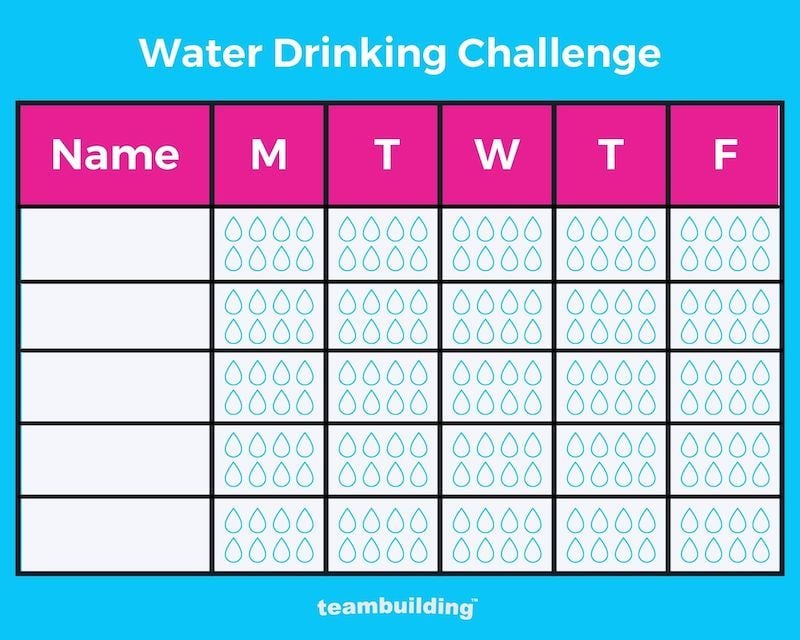
The water drinking challenge is one of the most beneficial online wellness challenge ideas. Work from home employees are only ever a few steps away from the kitchen. Plus, no coworkers are around to judge folks for taking a dozen bathroom breaks a day. Nevertheless, employees might not be drinking enough water.
According to the Mayo Clinic, adults should aim to drink an average of eight cups of water a day. To ensure your virtual employees stay hydrated, launch a water drinking challenge. You can make a dedicated Slack channel, and message channel members to take drinks periodically throughout the day. You could also order a tracker water bottle for employees and challenge them to upload pictures of their empty canteens.
5. Clean Desk Challenge
Maintaining a tidy workspace promotes focus and mental health. You can encourage your virtual employees to keep their at-home offices neat by launching a clean desk challenge.
At the end of each workday or workweek, ask participants to upload photos or video clips of clean desks to a channel or form. Or, you can ask for pictures of clean desks at random intervals, which incentivizes employees to keep desks clean consistently. At the end of the challenge, you can award a larger prize to the teammate with the most clean desk pictures. Or, you can raffle off digital gift cards each day of the contest by pulling the winner from daily entries.
6. Online Group Workouts
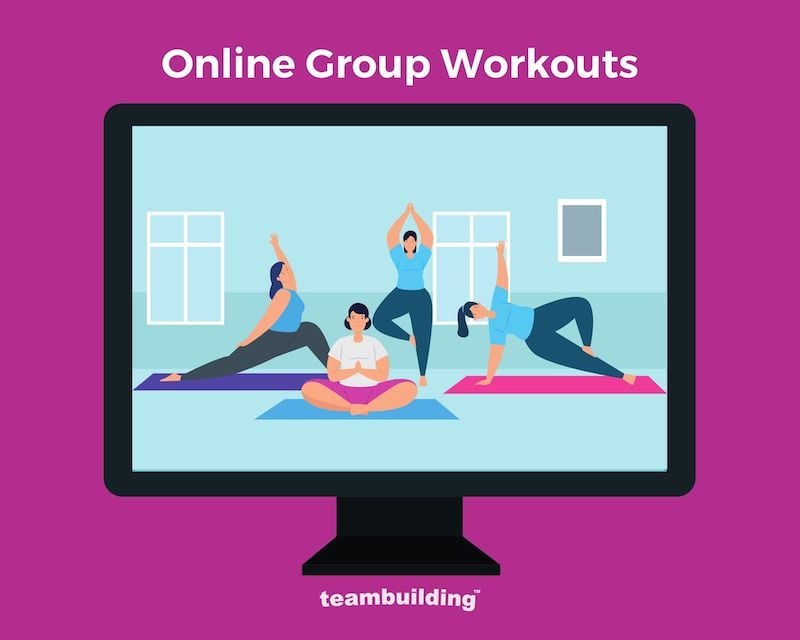
Desk jobs tend to be sedentary, and work at home employees may walk even less. One way to encourage staff to move is to host online group workouts. The best way to host an online exercise class for staff is to send a recurring calendar invite that includes a video meeting link. When the class begins, staff meet via video call and workout together. You could either hire a fitness instructor to lead the session, or recruit an athletic team member and compensate them with a perk like a bonus or extra time off.
For more information, check out our guide to virtual team fitness, and these team building workouts.
7. Virtual Fitness Challenge
If your staff is web-cam workout shy, or if they prefer to workout alone, then you can institute a virtual fitness challenge. First, set a goal such as “take a daily walk,” or “do ten minutes of cardio every day.” You could choose more interesting and harder challenges too, such as couch to 5k. Next, set a time period for the challenge, such as a quarter or month.
Employees will log whether or not they complete the goal each day. We created a free tracker tool to keep score. You could also track progress through apps like Map My Run or Espresa.
At the end of the challenge, give a prize to the employees who complete the full run. You can offer a more significant reward to the teammate with the most impressive results. If budget allows, then award all finishers a prize such as a $10 gift card. This approach will incentivize participants to stick with the challenge instead of quitting after the first time they fail.
8. Zoom Yoga or Stretch Sessions
Zoom Yoga or Stretch Sessions are some of the best wellness activities for remote employees. Yoga is a form of exercise that also doubles as stress relief and meditation. Work from home employees are less likely to work up a sweat striking a downward dog pose than doing jumping jacks. Thus, teammates are more likely to join midday yoga or stress sessions.
To host Zoom Yoga or stretch sessions, first find a fitness instructor or teammate willing to teach, or select a good yoga routine video. Then, send a calendar invite with a meeting link to employees. We recommend scheduling a recurring weekly 15 minute event.
Taking a break to stretch or perform yoga helps encourage remote employees to move and refocus throughout the day.
For more information, check out our guide to team building yoga.
9. Digital Step Challenges
Home office work does not involve commuting, conference rooms, lunch runs, or trips to officemates’ cubicles. As a result, remote workers tend to clock less steps than their in-office counterparts.
You can inspire virtual employees to walk more by issuing a digital step challenge. First, decide on a goal, such as 6,000 steps a day. Many smartphones already have a built-in step-counter participants can use to track steps. Employees could also use an app, fitness tracker, smartwatch, or old-fashioned pedometer. Ask employees to record their progress, then check in on a weekly basis.
For extra fun, award prizes for certain amounts of steps. For example, participants who exceed the goal by 20,000+ steps might win an Amazon gift card. You could even track cumulative results and give updates such as, “together this month we walked 500 miles– the distance between here and New York City!”
10. Virtual Wellness Retreat
Many companies plan wellness retreats for employees. Even if your organization is fully remote, you can invite teammates to participate in a day or two of health-focused events together by planning a virtual wellness retreat.
Virtual wellness retreats consist of online workshops, webinars, and classes.
Here are a few virtual wellness retreat ideas:
- guided meditations
- yoga and fitness sessions
- nutritionist consultations
- healthy cooking classes
- storytelling workshops
- goal-setting sessions
- self-compassion exercises
- relationship counselling
- digital mindfulness worksheets
- ask-a-doctor chats
These virtual health retreats give employees the chance to practice self-care, learn valuable skills, and connect with colleagues. Attendees may even score digital swag bags with healthy services like online workouts, meal subscription trials, and reference materials.
For more inspiration, check out our list of virtual retreat ideas.
11. Midday Meditations
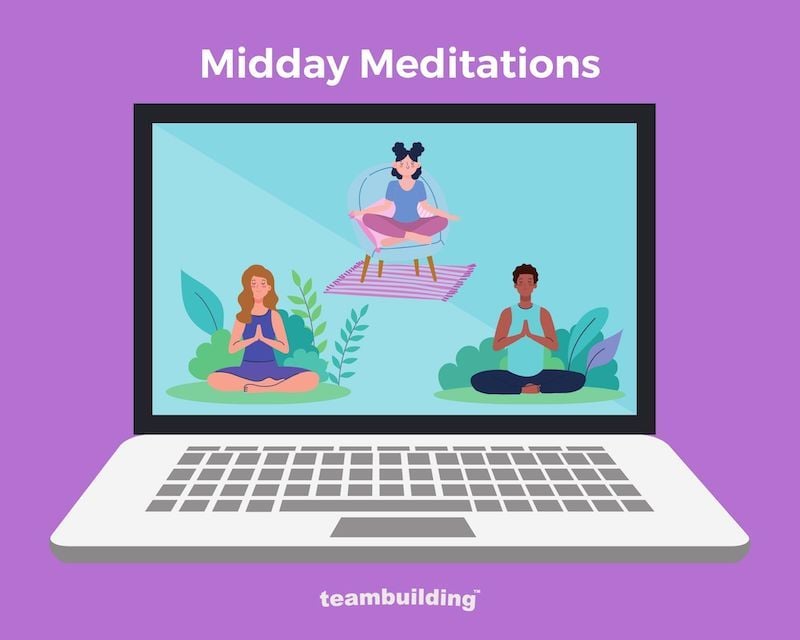
Even without the distractions of a traditional office, remote teammates can struggle with focus. One way to encourage mindfulness and decrease stress is to host midday meditations. Each workday, send an alert to participants to take a moment to breathe and clear their minds. You could ask an employee to guide the meditation, watch a video together, or use an app like HeadSpace. Or, you could make your own company meditation portal and have folks upload calming pictures, music, and audio meditations.
12. Mr. Rogers Calls
Loneliness is one of the biggest health risks for remote employees. To combat isolation, institute Mr. Rogers Calls. First, create a Slack channel and invite interested participants. Then, install the Donut app to randomly pair members for chats. We recommend setting the app on one week intervals, but you could assign matches more or less frequently.
Donut pairs participants and prompts them to schedule a video call. If you integrate virtual meeting platforms like Zoom or Google Meet and grant Slack access to virtual calendars, then Donut will propose times and set up the call with the click of a button.
Teammates meet up for a short video call, and talk about anything besides work. If your remote colleagues have trouble thinking up talking topics, then they can refer to this list of icebreakers.
13. Virtual Happy Hours
Healthy employees have thriving social lives and positive relationships with colleagues. Both of these accomplishments can be hard to master when working from home. Virtual happy hours help teammates bond and get face to face interaction.
During virtual happy hours, colleagues meet up on video conference software, sip drinks, play games, and wind down from the workday or workweek together. With Zoom happy hours, there is no need to worry about the noise level in the pub or coordinating a ride home afterwards. Plus, busy or faraway colleagues are more likely to make an appearance, since attending is as easy as clicking a link.
To stick with the theme of well-being, you could even host dry virtual happy hours where attendees indulge in nonalcoholic beverages like milkshakes or mocktails.
For more tips, check out our guide to virtual happy hours.
14. Healthy Cooking Club
Remote employees do not have to worry about the temptations of cake in the breakroom or impromptu lunches out. Yet staff might still not eat nutritious meals while working from home. To encourage remote workers to eat balanced meals, start a healthy cooking club.
Staff can swap healthy recipes via a collaborative Google Doc or link collector, and can upload pictures of finished dishes to a cloud-based photo album. You could even schedule ongoing remote dinners or virtual cooking sessions based around healthy meals, or send participants meal kits.
For more ideas, check out our list of online cooking classes.
15. Meal Subscriptions
In theory, the absence of a commute gives employees more time to cook healthy meals. In reality, many telecommuters often work even more at home, and dinner becomes a bag of Doritos or takeout from the Chinese restaurant down the street.
Even if you plan online cooking classes and group meal prep sessions, some employees may not take part. After all, cooking from scratch requires grocery shopping and prep, and some folks lack the time or energy.
Healthy meal subscriptions are a great alternative. They take the place of catered office meals, and you can offer them once a twice a week or month, depending on budget and need. You can either order a fully-prepared meal, or one that requires very little effort to assemble.
For more information, here is a New York Times guide to the best meal kits.
16. Wholesome Snack Packs

Many companies stock communal break rooms with nutritious snacks. Work from home employees can benefit from healthy bites too.
To keep your staff energized, periodically send them wholesome snack packs full of healthy foods.
What to include:
- Granola bars
- Baked chips
- Popcorn
- Pretzels
- Nuts
- Organic fruit snacks
- Peanut butter pouches
- Apple sauce packets
- Whole grain crackers
- Low-sugar dried fruits
If you would rather not assemble and mail the packages by hand, then you can order an assortment online, like this vegan snack box from Amazon.
17. Online Art Therapy
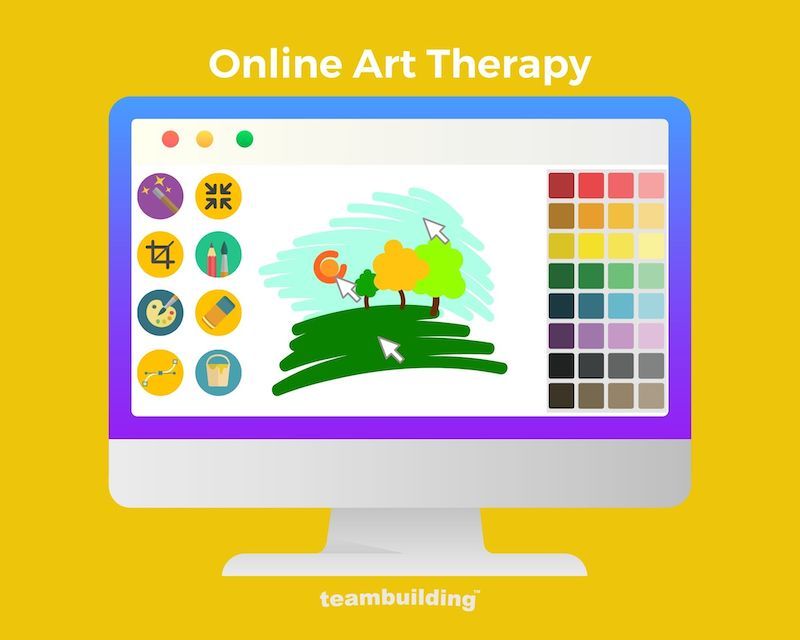
Art can be therapeutic, especially if your employees work in highly technical positions.
There are a variety of ways to host online art therapy for your staff:
- Doodle together on a digital whiteboard
- Create a digital mural in Miro or Google Sheets
- Attend Zoom paint and sip sessions
- Book virtual art classes
- Issue a monthly photo challenge
- Send craft kits and adult coloring books to employees
- Ask teammates to send each other homemade gifts, such as cards or origami animals
- Create a Slack channel or cloud photo album where staff can share art creations
- Make a team scrapbook by asking each teammate to create a page and mail it to the manager. Scan the final product and send all participants a digital copy.
For more recommendations, check out our list of online art classes.
18. Virtual Health Fair
Many employers host health fairs for staff, and virtual offices can join this tradition. To host a health fair virtually, plan a series of web sessions and virtual activities related to health and medical topics. You can recruit health care providers and vendors to give virtual talks and demonstrations.
Some virtual health fair ideas:
- Online CPR courses
- Mini telemedicine check-ups
- Self-exam tutorials
- Tips for work at home health
- Healthy meal planning workshops
- Survival skills and first aid Zoom classes
- Information sessions about employee benefits
- Online company store with healthy products
When planning your fair, reach out to your health insurance carrier, preferred medical providers or company health team, and health vendors to inquire about more virtual options.
19. Online Mental Health Fair
Mental health is just as important as physical health. Due to the individual nature of remote work, it is extra important to monitor employees’ mental and emotional wellbeing. By hosting online mental health fairs, you can set up a series of virtual activities and informational sessions that teach staff how to manage stress, express emotion, and cultivate mindfulness.
Online mental health fair ideas:
- Teletherapist meet and greets
- Guided virtual yoga and meditation
- Zoom support groups
- Journaling prompts
- Coping skills workshops and worksheets
- Self-help podcasts
- Tips on managing workplace stress
- Random acts of digital kindness
Holding online seminars about mental health de-stigmatizes the subject and encourages employees to ask for help when necessary.
Here is a list of ideas for Mental Health Awareness Month.
20. Traveling Meetings
One of the perks of telecommuting is the ability to take meetings from unconventional locations. Following this logic, you can encourage employees to get exercise during calls by taking walks. Once a month, hold traveling meetings. Participants join the call by dialing in via phone or smart watch, and stroll through a park, beach, or city center. Traveling meetings help remote employees get exercise, fresh air, and sunshine.
21. Virtual Volunteering
According to Harvard Health, volunteering can boost both mental and physical health. If you lead dispersed teams, then you may not be able to rally the crew for an off-site service day. Nevertheless, your remote team can volunteer virtually.
First, choose a cause as a team. Then, coordinate a day to make complete activities together. For instance, you could meet up on Zoom to write letters to troops, tutor school children, lead a community workshop, or video chat with nursing home residents. Teammates get a chance to socialize with each other and bond over a shared mission.
If your team does not have the time or bandwidth for online volunteering, then team members can make monetary donations. You could provide a stipend for employees to put towards the philanthropy of their choosing, or offer to match any charitable donations up to a certain amount.
For suggestions, check out our list of online volunteering ideas and these employee volunteer programs.
22. Digital Pet Therapy
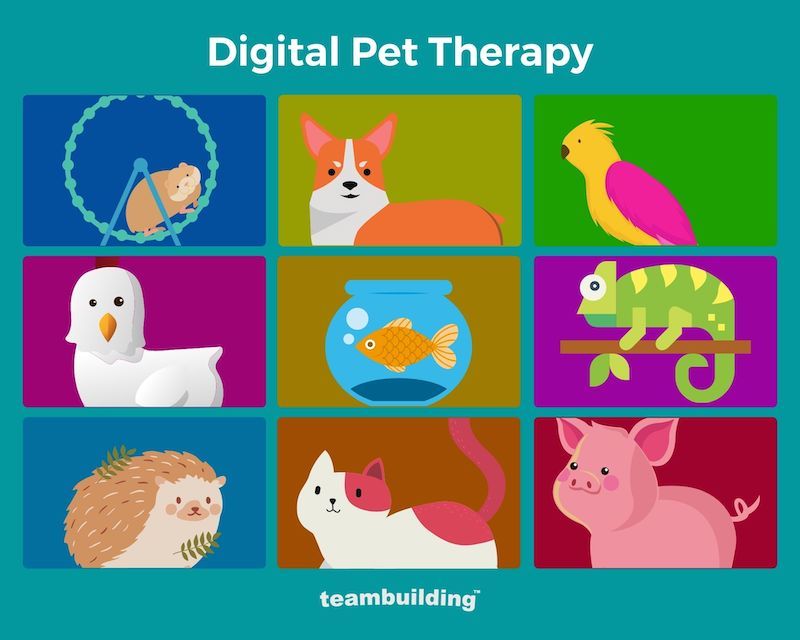
Pets are instant mood boosters. To help your remote team get their animal fixes, schedule recurring digital pet therapy. Simply invite interested parties to a Zoom call, then take turns showing off furry friends. Cats and dogs are the likeliest guests, but the activity is extra fun if colleagues have exotic pets like hedgehogs, chickens, or chameleons.
If conflicting schedules prevent the group from meeting, then create a group chat or Slack channel where teammates can swap pictures of cute animals instead.
Here is a list of the best office pets, and this one has ideas for bring your dog to work day.
23. Treat Yourself Allowance
Treat yourself allowances are modest stipends bookmarked for small indulgences. Once per month or per quarter, permit remote employees up to $15 to spend on an item or service that brings them joy. Examples might include gourmet marshmallows, an hour at the batting cage, or a set of fake moustaches.
There are only 3 rules:
- Employees must spend the money on themselves.
- The object should not serve a practical purpose.
- Participants must upload pictures of themselves enjoying the treat.
Treat yourself allowances double as a “getting-to-know-you” activity and remind remote employees that having fun at work is important.
24. Career Coaching
Professional development is a key element of employee satisfaction. To keep remote employees’ skills sharp and careers thriving, provide coaching as part of the wellness program. You could either cover costs of a set number of sessions, or partner with a coaching company to offer employees a discounted rate on services. These sessions can fill in the gap between virtual one on one meetings. Not to mention, they provide employees with a safe space to explore options and a neutral party to bounce ideas off of.
25. Life Coaching
Virtual life coaching is another service option to offer in your wellness program. Life coaching takes a more holistic approach than career coaching. Instead of focusing solely on job satisfaction or personal wellbeing, life coaches take a big-picture approach and help patients achieve balance in all areas. You can negotiate a discounted rate for employees, or offer every teammate a complimentary introductory session.
26. Professional Organizers
Clean home office spaces are pivotal to remote work success. Clutter can increase employee stress, not to mention lead to workday procrastination. By offering professional organizer services, you can help your teammates keep their workspaces tidy and conducive to productivity.
The organizers can make “virtual house calls,” via Zoom consultations and advise employees on how to best optimize their space. Not only will the organizers help clean up the clutter, they will also teach staff skills and develop systems to maintain order.
27. Virtual Water Cooler
Social ties are important to workplace wellness. A survey from the Society for Human Resource Management found that employees with work friends are less likely to seek or accept new job offers from outside organizations.
Remote employees have less opportunities to mingle and develop natural rapport with colleagues. Virtual water coolers provide environments where remote coworkers can chat and build friendly relationships.
To create a virtual water cooler, designate an online forum like Slack channel or group chat for casual, non-work banter. Managers can spur conversation by occasionally commenting within the feed.
Here is a guide to creating virtual water coolers.
28. Online Game Lounge
Traditional offices sometimes offer perks like ping pong tables, arcade games, and board games so that employees can socialize and relax. Virtual offices can achieve the same results by building an online game lounge. Simply make a Slack channel or an always-on video meeting room where remote employees can go to play games with colleagues. Or, use a game app or collaborative gaming website instead.
For suggestions, check out our list of Slack games or ideas for virtual game night.
29. Online Employee Book Club
Online book clubs offer employees personal enrichment and social time. Every month, give participants a reading assignment. You could send members a physical or digital copy of the book, or offer to reimburse the cost of purchase. Teammates will meet up on a Zoom call to discuss the book in real-time, or will post reflections on an internal forum or Slack channel.
Chosen books do not have to be work-related. Members can read recent bestsellers or personal favorites instead. Be sure that the selected title is work-appropriate and accessible.
For reading suggestions, check out our list of team building books.
30. Goal Sharing Sessions
One way to motivate employees and maintain morale is to encourage staff to share goals with each other. First, create a hub where teammates can post goals, such as a Slack channel, cloud document, or collaborative whiteboard. Next, create a goal tracking spreadsheet and share it with participants. On a regular basis, check in with the team for updates. Throughout the exercise, teammates provide each other with encouragement and advice on how to accomplish goals.
Be sure to encourage employees to react to and celebrate each others’ announcements and milestones. For extra incentive, award victorious participants with a prize such as a complimentary meal, virtual party, or a digital badge.
Here is a list of ways to motivate remote workers.
31. Digital Coworking Hours
Digital coworking hours helps to eliminate remote work-induced isolation. Simply designate a block of time where dispersed team members can log in via Zoom and work silently together. Teammates do not need to be silent for the full time, and can exchange banter and ask each other questions. This activity simulates in-person office experiences and helps to build rapport between dispersed colleagues.
Here is a guide to digital coworking.
You could also do a virtual hackathon.
32. Virtual Employee Financial Wellness Programs
Economic health is an important facet of overall well being. By launching virtual employee financial wellness programs, you ensure that your teammates’ monetary health is as strong as their physical and mental health.
These programs can consist of Zoom meetings with financial advisors, digital financial literacy workshops, trials or subscriptions to fintech apps, as well as worksheets, websites, virtual calculators, podcasts, and videos that help employees learn how to better manage money.
33. Inspirational Quotes
One of the easiest free virtual wellness activities is to share motivational quotes with employees. You can include these quotes in company communications, such as internal emails or announcements. Or, you could create a channel where employees can post and react to quotes. For maximum effectiveness, share sayings regularly, such as a quote of the day or week. To make the exercise more interactive, call on employees to find and share powerful quotes on a rotating basis.
Check out our list of positive quotes for work.
34. Team Wellness Emails
Team wellness emails are one of the easiest employee wellness program ideas. You can send regular emails to remote staff members highlighting healthy topics.
Here are some topic ideas:
- Avoiding procrastination
- Working with proper posture
- Setting realistic goals
- Easy at-home workouts
- Showing gratitude for remote colleagues
- Navigating work from home conflicts
- Beginning or end of day self-care rituals
The emails can be about general health points, or work from home wellbeing. Sending these messages serves as a reminder for remote workers to take care of themselves and each other, and assures your team members that you care.
35. Digital Mentors
Virtual employees sometimes miss out on the coaching and advising opportunities available in traditional office settings. One solution to this problem is to launch a digital mentoring program. By matching remote employees with senior-level teammates, you give your crew a backup resource for times when managers are unavailable. Because the nature of these relationships is more informal, remote employees can ask mentors questions and advice they might not feel comfortable asking direct superiors. Plus, an online mentorship program adds an extra level of professional support and human contact to online offices.
To run your program, first ask for mentor volunteers, and then accept sign-ups from mentees. Next, match up your pairs, and make an introductory email. You may want to suggest a minimum number of monthly meetups or set up the first call.
36. Virtual Buddy System
Virtual Buddy Systems are a sort of online pen pal program. It is harder to forge work friendships in online environments, but the buddy system facilitates the process. Simply match up two dispersed employees, and set a schedule for them to check in with each other.
Online buddies can send each other inspiring quotes, funny gifs, online game challenges, interesting articles, and can meet up for casual conversation or virtual bonding time. The relationship should be ongoing. If one half of the pair leaves the company or opts out of the activity, then be sure to re-match the remaining participant. The purpose of the program is that every remote employee has a friendly face to reach out to within the company at all times.
Learn more about creating friendships at the office.
37. Online Employee Resource Groups
Remote workers often report feeling lonely, and so do members of underrepresented groups. Even if employees get along with remote teammates, they may benefit from connecting with colleagues from similar backgrounds and demographics.
One of the best virtual employee wellness program ideas is to give staff access to online employee resource groups. These groups can have members-only chats and channels and hold regular Zoom meetings. Examples of support groups include meetups for race and cultural identities, gender, LGBTQ+, religions, grief and loss, and working parents.
Telecommuters can meet like minded individuals, ask advice from peers with similar experiences, and get the support they need. If your organization is too small for significant membership in these groups, then you can point employees towards outside organizations, such as groups run by industry or community organizations.
Here is a list of ideas for employee resource groups at work.
38. Daily Brain Teasers
Keeping employees’ brains sharp is just as important as keeping their bodies fit. To give remote staff regular mental workouts, send brain teasers. You can include the puzzles in team emails and Slack threads, or pose problems as an icebreaker in virtual meetings. Offering small rewards like digital Starbucks cards or virtual high fives from the boss encourages participation.
For inspiration, check out our list of team building brain teasers.
39. Work-life Balance Workshops
Remote workers often struggle to self-regulate and self-manage. Some employees overwork, while others under-work and are easily distracted. Establishing and maintaining boundaries is difficult. By offering ongoing remote work-life balance workshops, you set virtual employees up for success.
These seminars can take the form of Zoom lectures from experts, or group discussions on challenges and goals. Attendees can swap strategies and practice skills like active listening and email correspondence.
We recommend holding these events at least once per quarter, as part of the virtual new hire onboarding process. You could also send employees tips for working from home.
40. Online Lunch and Learns
Online lunch and learns are one of the most common virtual wellness activities for employees. These online events help employees learn and grow and offer face-to-face time with colleagues.
To host online lunch and learns, recruit speakers to present on subjects relevant to employees. The talk topics might be industry-specific, such as public speaking tips for sales advisors, or general job skills like time management. You could also host life-skills sessions such as retirement planning or language learning, or just-for-fun lessons like succulent gardening. Once you set a time for the meeting, send invitations with the virtual meeting link.
Here are ideas for online lunch and learns.
Conclusion
Wellness programs are important for employees. With remote workers these programs are even more important. Due to the independent nature of virtual work, it can take longer to realize that a teammate is struggling. Telecommuters can also use occasional reminders to take care of themselves.
By offering a robust virtual employee wellness program, you communicate that you care about your remote staff and give your workers the tools and resources to live a more well-balanced and beneficial lifestyle. Over time, these practices can result in higher productivity, employee engagement, and retention rates and lower absenteeism, turnover, and insurance costs.
Next, check out our guide to employee benefits software, this one on 4-day workweeks and this one with HR management books.
We also have a list of reasons why employees quit jobs and company retreat ideas for work. Plus a list of ideas for employee stress management, and a list of ideas for virtual stress relief.
